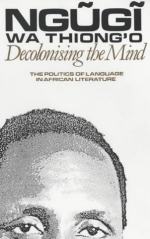|
This section contains 893 words (approx. 3 pages at 400 words per page) |

|
Summary
In Part IV of Chapter 1, Ngũgĩ addresses the relationship between human experience, human culture, and human perception of reality, Language becomes the means of communication and a carrier of culture, he explains. In Kenya and Tanzania, Swahili is both of these things, while in England, English serves both purposes. As communication, language is the language of “real life,” a Marx-inspired idea in which language establishes the relations people enter into with one another and with labor. Meanwhile, speech, which imitates the language of real life through “verbal signposts” (14), allows humans to negotiate their relationships, while written forms of language imitate the spoken word by representing sounds with visual symbols.
To this Ngũgĩ adds that communication is also the “basis and process of evolving culture” (14). As certain actions and thoughts accumulate, they create certain value systems...
(read more from the Chapter 1 (Parts IV-V): The Language of African Literature Summary)
|
This section contains 893 words (approx. 3 pages at 400 words per page) |

|




